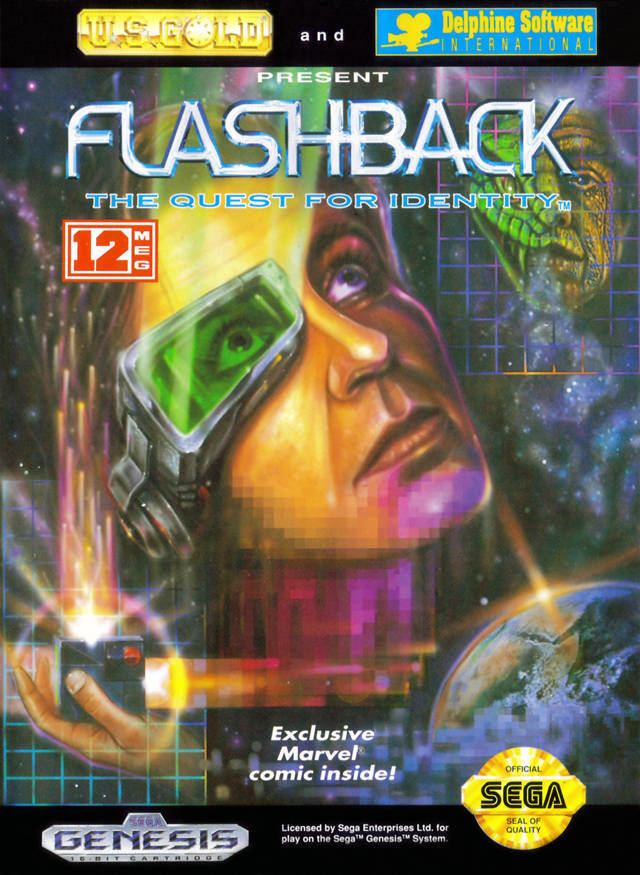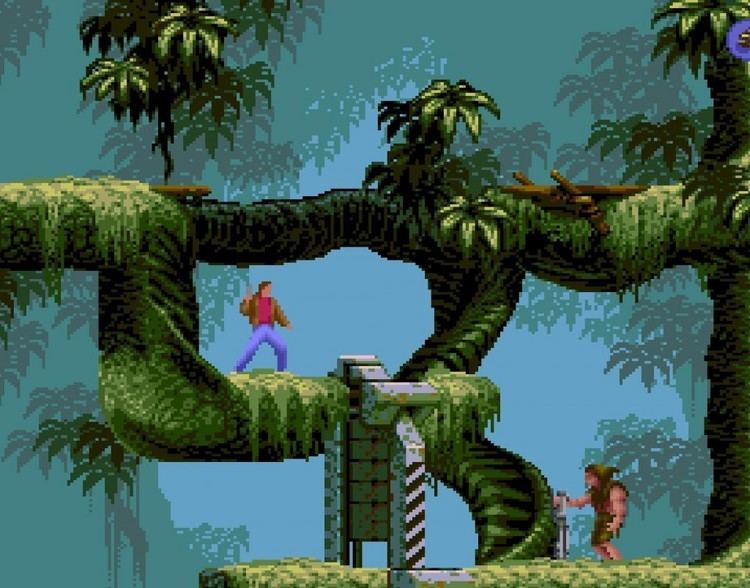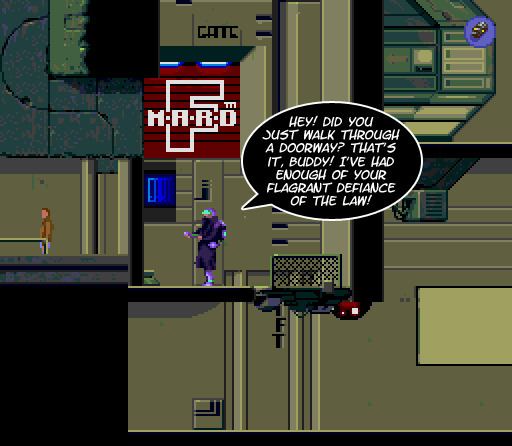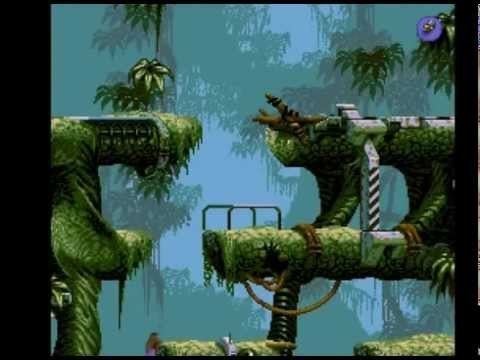Genre(s) Cinematic platformer | Initial release date 1992 | |
 | ||
Similar Delphine Software International games, Platform games | ||
Flashback, released as Flashback: The Quest for Identity in the United States, is a 1992 science fiction cinematic platform game developed by Delphine Software of France and published by U.S. Gold in United States and Europe, and Sunsoft in Japan.
Contents

The game was directed, written/designed and partially programmed by Paul Cuisset, who had previously created the adventure game Future Wars. Flashback was initially released for the Amiga in 1992, although originally created for the Mega Drive/Genesis, and then ported to MS-DOS, Acorn Archimedes and Super NES in 1993 - at which time the Sega Mega Drive/Genesis version was also released. CD-ROM versions of Flashback for the Sega CD, 3DO, CD-i, MS-DOS, Apple Macintosh and the FM Towns were released during 1994 and 1995, together with a cartridge version for the Atari Jaguar in 1995.

Originally advertised as a "CD-ROM game on a cartridge", the game features fully hand-drawn backdrops and all animation is rotoscoped, giving movements an unusual fluidity, similar to that of the earlier Prince of Persia. The capture technique of Flashback was invented independently of Prince of Persia, and used a more complicated method of first tracing video images onto transparencies.

The game was a commercial and critical success and was listed in the Guinness World Records as the best-selling French game of all time. It was followed by a sequel titled Fade to Black in 1995. In 2013, a Flashback remake by VectorCell was released for the PC and consoles.

Gameplay

As a cinematic platformer, Flashback features gameplay similar to that of 1989's Prince of Persia, and Delphine's own Another World released in 1991. Each level spans a large number of non-scrolling screens, nearly all of which feature multiple levels of altitude — requiring the player character Conrad to jump, grab onto ledges, climb, use elevators, and drop onto lower levels. Conrad exhibits realistic human running speed and jumping ability, as well as realistic weakness — he will die if he falls from too great a height.

Conrad also carries a pistol with unlimited ammunition, a force shield which absorbs a certain number of shots before needing recharging, acting as Conrad's health, how many attacks he can survive before dying, and a portable force field with unlimited use, which can act as a temporary barrier to block enemies' shots.
As Conrad progresses through the game's seven levels, he is increasingly presented with spatial puzzles, requiring the player to discover how to guide him toward his destination. Late in the game, Conrad receives a teleportation device, and is able to progress by throwing the device and teleporting into otherwise unreachable areas.
Plot
In the year 2140, an amnesiac Conrad B. Hart is chased by mutants and crash-lands his hover bike in a jungle on Titan. He finds a holocube which fell from his pocket. It contains a recorded message from himself, telling him to meet his friend Ian in New Washington. He makes his way through the jungle and purchases an anti-gravity belt in order to enter New Washington via chasm.
He finds Ian being attacked by cops. After he kills them, Ian uses a regenerator to restore Conrad's memories: For his "end of year thesis" he had built glasses which measure molecular density and inadvertently discovered that shapeshifting aliens called Morphs, distinguished by their high density, had mixed into the human population. The Morphs realized he was investigating and targeted him. Anticipating memory erasure, he recorded the holocube, and sent a copy of his memory to Ian. Conrad is determined to return to Earth. Ian tells him that the only a way he can afford a ticket to Earth is to win one in Death Tower, a game show in which contestants fight to the death, and false papers are required for a pass. To pay for the forged papers, Conrad takes a series of dangerous jobs in the city. He finds himself continually targeted by police, who have presumably been misled by Morph infiltrators.
Conrad wins Death Tower, and travels to Earth. His false papers get him past the checkpoint, but the Morphs soon realize who he is and Conrad is pursued by more cops. He takes a taxi to the Paradise Club, which conceals the Morphs' hideout. He spies on three Morphs through a ceiling vent. They discuss their plan to conquer Earth within hours. Conrad falls through the vent and is taken to a prison cell. Soon, Morphs enter his cell to kill him. Conrad runs past them and picks up a discarded alien gun. Exploring the facility, he discovers a teleporter, and uses it to transport himself to the Morphs' home planet.
He finds a human prisoner named Phillip Howard Clark. As he opens his prison, a Morph appears and executes Phillip. The dying Phillip gives Conrad an atomic charge. Phillip's diary reveals he had planned to destroy the "Master Brain" that controls the aliens, located at the planet's core, but the "Auxiliary Brain" must be destroyed to open up the communication pathways to the Master Brain. Conrad finds and destroys the Auxiliary Brain and then the Master Brain. As he arrives at a certain spot, he hears Phillip's voice, telling him that the atomic charge should be placed on a loose platform. After he does so, he throws a switch, causing a tremor which drops the charge towards the core. Conrad runs to the hangar and takes a spacecraft out of the planet's atmosphere before it detonates. As the Morphs' galaxy is not on any human star charts, he cannot navigate home, and instead puts himself in suspended animation while his ship drifts into space, leading up to the events of Fade to Black.
Development and release
The PC version has an extended introductory sequence and more minor cut scenes than the Amiga version, such as when picking up items. In the Amiga version, the user can see these scenes by enabling them (although with few seconds of delay every time the animations load) or by playing the game entirely from the hard drive. The Amiga version also had an option to zoom in on the action whenever Conrad opens fire. Due to criticism of the look, it was removed from all other versions, although an option to play the game zoomed in remained in the PC version. The message that Conrad writes in the ending was also different in this release.
The game was originally released on 3.5" floppy disk for MS-DOS. The re-release on CD-ROM for the Sega CD (later adapted to the PC CD-ROM, 3DO and CD-i) featured redone pre-rendered cinematic FMVs with voice acting and sound effects. The Sega CD version also has voice work for gameplay and CD tracks for each level which were not carried to the other CD-ROM conversions. The Jaguar port has the title screen that these versions have, but the music is different and the cutscenes are as on the original releases.
In issue #118 of Retro Gamer, Paul Cussiet told the magazine that "The best version for me is the Mega Drive version. The game was created for this platform", contrary to what many had believed before this article was published.
In North America, the Genesis, Super NES and Sega CD versions featured a Marvel comic book within the manual in order to explain the initial story. The PAL releases of the Mega Drive and Super NES versions (there was no Mega CD version in the PAL region) omitted the comic and instead featured a textual prologue. The Super NES port featured some minor censorship due to Nintendo's content guidelines at the time. Changes included New Washington's bar becoming a cafe and Death Tower being renamed Cyber Tower, while the enemy mutants (who had natural skin colors in other versions) were recolored green.
A two-track CD soundtrack was released featuring music inspired by the game, but not directly from it.
Reception
Computer Gaming World approved of Flashback's "superbly rotoscoped graphics", "fluid movement", and sound card audio. While criticizing the awkward interface and use of save points, the magazine concluded that it "is an excellent game that truly creates a sense of reality". Electronic Gaming Monthly praised the SNES version for having improved graphics and music over the Genesis version. They remarked that Flashback is slow-paced at times, but retains the player's interest through its compelling plot and involving puzzles. MegaTech magazine conceded that although there were "five big levels", finishing the game did not take very long. Nintendo Power praised the graphics, story and animation calling it "almost cinematic" while noting that the play control takes "some getting used to".
Electronic Gaming Monthly commented that the Sega CD version is "virtually identical" to the Genesis version, but that Flashback is still an essential purchase for those who do not already own a different version. GamePro, in contrast, argued that the reworked cutscenes "look so awesome that even gamers who've already completed this game on another platform will want to play it again just to see all the new CD footage". They also praised the addition of a CD-quality soundtrack and voices. A reviewer for Next Generation acknowledged that the Sega CD version makes considerable improvements, but argued that they are all standard cartridge-to-Sega CD enhancements which have no impact on the gameplay. However, he lauded Flashback itself for its graphics, animation, and "fiendishly clever puzzles", and said that though the game superficially resembles Another World and Heart of the Alien, it is "in a class by itself that easily surpasses them". Reviewing the Jaguar version, GamePro noted that it was merely a straight port with no enhancements to take advantage of the hardware, but that "the game is no less enjoyable" than when it was first released to game consoles over a year before.
Reviewing the Macintosh version in Next Generation, a critic applauded the game's animation, story sequences, plot, level design, and longevity.
Flashback was listed in the Guinness World Records as the best-selling French game of all time. The Mega Drive version became a bestseller.
In 1994, Mega placed the game at number eight in their list of top Mega Drive games of all time. In February 2011, Wirtualna Polska ranked it as the 17th best Amiga game and the Polish edition of CHIP ranked it as the tenth best Amiga game. In 2004, readers of Retro Gamer voted Flashback as the 65th top retro game.
Legacy
A sequel titled Fade to Black was produced by Delphine Software International in 1995 for the PC and PlayStation as a 3D game. A third game in the series, Flashback Legends, was in development by both Delphine Software International and Adeline Software International for a planned released in 2003, but was cancelled when the company went bankrupt and ceased operations at the end of 2002.
In early 2013, a game titled Flashback Origins was rumoured to be in development, with the French website Gameblog stating that €300,000 of government funding had been granted to Cuisset's VectorCell in 2011. On April 11, 2013, a remake of Flashback was announced with a reveal trailer.
Related software
REminiscence, a game engine recreation, was created by Gregory Montoir (cyx). The engine is available for Amiga OS4, Dreamcast, GP2X, iPhone, Linux, Microsoft Windows, Mac OS X, Maemo, MorphOS, Nintendo DS, Wii, Palm OS, PlayStation 2, PlayStation Portable, Sega Saturn and Windows CE. There is also one for the Xbox 360 by MagicSeb. A port for Symbian and Maemo 5 by Ronen K is available.
OnEscapee was originally developed as an Amiga CD title, and has since been released as PC freeware. The game contains many similarities to both the Flashback style of gameplay and concept.
